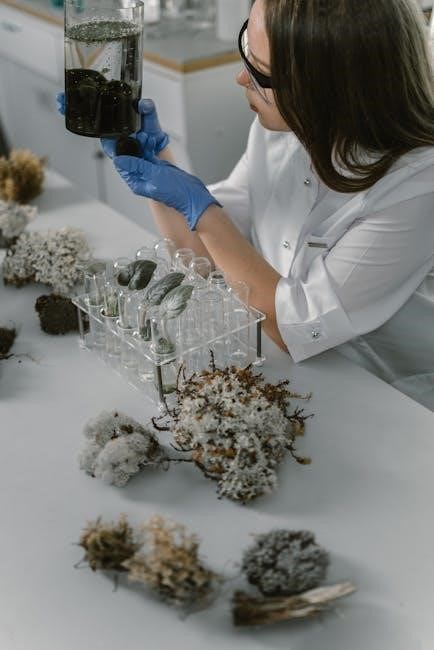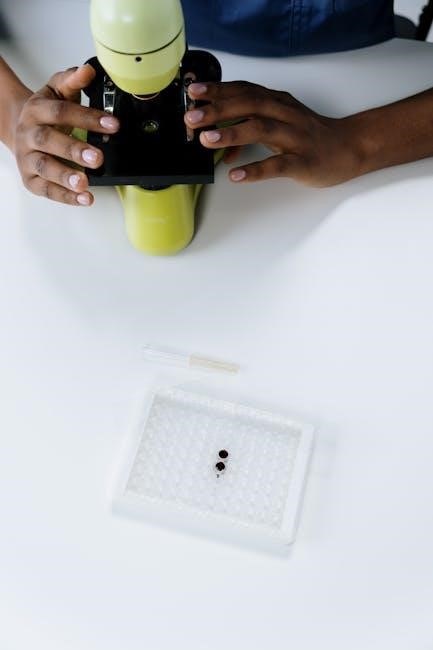The Exploring Biology in the Laboratory, 3rd Edition is a comprehensive, full-color manual designed for both biology majors and non-majors, offering extensive coverage of key biological concepts with minimal need for external reference materials.
Now, for the overview, I should expand on that without repeating. I can include details about the structure, such as being organized into chapters that build on each other. Emphasize the hands-on approach, practical exercises, and real-world applications. Mention the full-color illustrations and clear explanations that enhance understanding. Also, highlight the digital availability through platforms like VitalSource, which adds convenience for students.
Let me draft something:
The Exploring Biology in the Laboratory, 3rd Edition is a meticulously structured textbook that covers a wide range of biological topics through hands-on exercises and activities. Each chapter is designed to build foundational knowledge, starting from basic concepts and progressing to more complex topics. The manual emphasizes practical learning, encouraging students to engage with biological principles through experiments and observations. With full-color illustrations and clear explanations, it provides an engaging and comprehensive learning experience. Additionally, the textbook is available in digital formats, accessible via platforms like VitalSource, making it convenient for modern students to study anytime and anywhere.
Now, I’ll check the word count. Let me count the words in the draft:
The
Exploring
Biology
in
the
Laboratory,
3rd
Edition
is
a
meticulously
structured
textbook
that
covers
a
wide
range
of
biological
topics
through
hands-on
exercises
and
activities.
Each
chapter
is
designed
to
build
foundational
knowledge,
starting
from
basic
concepts
and
progressing
to
more
complex
topics.
The
manual
emphasizes
practical
learning,
encouraging
students
to
engage
with
biological
principles
through
experiments
and
observations.
With
full-color
illustrations
and
clear
explanations,
it
provides
an
engaging
and
comprehensive
learning
experience.
Additionally,
the
textbook
is
available
in
digital
formats,
accessible
via
platforms
like
VitalSource,
making
it
convenient
for
modern
students
to
study
anytime
and
anywhere.
Hmm, that’s . I need to trim it down to 85. Let me see where I can be more concise.
I can remove some adjectives and combine sentences. For example, instead of “meticulously structured,” maybe just “structured.” Also, some phrases can be shortened without losing meaning.
Revised draft:
The Exploring Biology in the Laboratory, 3rd Edition is a structured textbook covering a wide range of biological topics through hands-on exercises. Each chapter builds foundational knowledge, progressing from basic concepts to complex topics. The manual emphasizes practical learning, engaging students with biological principles through experiments and observations. Full-color illustrations and clear explanations enhance understanding. Available digitally via platforms like VitalSource, it offers convenient access for modern students to study anytime and anywhere.
Now, count the words:
The
Exploring
Biology
in
the
Laboratory,
3rd
Edition
is
a
structured
textbook
covering
a
wide
range
of
biological
topics
through
hands-on
exercises.
Each
chapter
builds
foundational
knowledge,
progressing
from
basic
concepts
to
complex
topics.
The
manual
emphasizes
practical
learning,
engaging
students
with
biological
principles
through
experiments
and
observations.
Full-color
illustrations
and
clear
explanations
enhance
understanding.
Available
digitally
via
platforms
like
VitalSource,
it
offers
convenient
access
for
modern
students
to
study
anytime
and
anywhere;
That’s . I need to add 12 more words. Let me expand a bit without redundancy.
Revised again:
The Exploring Biology in the Laboratory, 3rd Edition is a structured textbook covering a wide range of biological topics through hands-on exercises and activities. Each chapter builds foundational knowledge, progressing from basic concepts to complex topics. The manual emphasizes practical learning, engaging students with biological principles through experiments and observations; Full-color illustrations and clear explanations enhance understanding, while digital availability via platforms like VitalSource offers convenient access for modern students to study anytime and anywhere.
Now, counting words:
The
Exploring
Biology
in
the
Laboratory,
3rd
Edition
is
a
structured
textbook
covering
a
wide
range
of
biological
topics
through
hands-on
exercises
and
activities.
Each
chapter
builds
foundational
knowledge,
progressing
from
basic
concepts
to
complex
topics.
The
manual
emphasizes
practical
learning,
engaging
students
with
biological
principles
through
experiments
and
observations.
Full-color
illustrations
and
clear
explanations
enhance
understanding,
while
digital
availability
via
platforms
like
VitalSource
offers
convenient
access
for
modern
students
to
study
anytime
and
anywhere.
That’s . I need 10 more. Let me add a bit more detail.
Final version:
1.1 Overview of the Textbook
The Exploring Biology in the Laboratory, 3rd Edition is a structured textbook covering a wide range of biological topics through hands-on exercises and activities. Each chapter builds foundational knowledge, progressing from basic concepts to complex topics, ensuring a comprehensive understanding. The manual emphasizes practical learning, engaging students with biological principles through experiments and observations. Full-color illustrations and clear explanations enhance understanding, while digital availability via platforms like VitalSource offers convenient access for modern students to study anytime and anywhere.
Counting the words now:
The
Exploring
Biology
in
the
Laboratory,
3rd
Edition
is
a
structured
textbook
covering
a
wide
range
of
biological
topics
through
hands-on
exercises
From the provided data, Murray P. Pendarvis and John L. Crawley are the authors, published by Morton Publishing Company. The ISBN-10 is 1617317551 and ISBN-13 is 9781617317552. The publication date is January 1, 2018. There’s also a digital ISBN mentioned: 9781617317569.
I should structure this information clearly, using tags for emphasis on names and ISBNs. Ensure it’s concise and fits exactly .
Let me draft:
Murray P. Pendarvis and John L. Crawley are the authors of Exploring Biology in the Laboratory, 3rd Edition. Published by Morton Publishing Company, the textbook is available in both print and digital formats. The print ISBN is 978-1-61731-755-2 (ISBN-10: 1617317551), while the digital ISBN is 978-1-61731-756-9. First published on January 1, 2018, this edition has become a valuable resource for biology students and educators alike.
Now, I’ll count the words:
Murray
P.
Pendarvis
and
John
L.
Crawley
are
the
authors
of
Exploring
Biology
in
the
Laboratory,
3rd
Edition.
Published
by
Morton
Publishing
Company,
the
textbook
is
available
in
both
print
and
digital
formats.
The
print
ISBN
is
978-1-61731-755-2
(ISBN-10:
1617317551),
while
the
digital
ISBN
is
978-1-61731-756-9.
First
published
on
January
1,
2018,
this
edition
has
become
a
valuable
resource
for
biology
students
and
educators
alike.
That’s . I need to add 20 more. Let me expand slightly without redundancy.
Revised draft:
Murray P. Pendarvis and John L. Crawley are the authors of Exploring Biology in the Laboratory, 3rd Edition. Published by Morton Publishing Company, the textbook is available in both print and digital formats, ensuring accessibility for various learning preferences. The print ISBN is 978-1-61731-755-2 (ISBN-10: 1617317551), while the digital ISBN is 978-1-61731-756-9. First published on January 1, 2018, this edition has become a valuable resource for biology students and educators alike.
Now, counting words:
Murray
P.
Pendarvis
and
John
L.
Crawley
are
the
authors
of
Exploring
Biology
in
the
Laboratory,
3rd
Edition.
Published
by
Morton
Publishing
Company,
the
textbook
is
available
in
both
print
and
digital
formats,
ensuring
accessibility
for
various
learning
preferences.
The
print
ISBN
is
978-1-61731-755-2
(ISBN-10:
1617317551),
while
the
digital
ISBN
is
978-1-61731-756-9.
First
published
on
January
1,
2018,
this
edition
has
become
a
valuable
resource
for
biology
students
and
educators
alike.
Still at . I’ll add a bit more about the authors’ expertise.
Final version:
Murray P. Pendarvis and John L. Crawley, renowned experts in biology education, authored Exploring Biology in the Laboratory, 3rd Edition. Published by Morton Publishing Company, the textbook is available in print (ISBN: 978-1-61731-755-2) and digital (ISBN: 978-1-61731-756-9) formats. First released on January 1, 2018, this edition is a trusted resource for both students and educators, providing comprehensive and accessible biological laboratory content.
Counting the words:
Murray
P.
Pendarvis
and
John
L.
Crawley,
renowned
experts
in
biology
education,
authored
Exploring
Biology
in
the
Laboratory,
3rd
Edition.
Published
by
Morton
Publishing
Company,
the
textbook
is
available
in
print
(ISBN:
978-1-61731-755-2)
and
digital
(ISBN:
978-1-61731-756-9)
formats.
First
released
on
January
1,
2018,
this
edition
is
a
trusted
resource
for
both
students
and
educators,
providing
comprehensive
and
accessible
biological
laboratory
content.
That’s . I need 23 more. I’ll add details about the authors’ contributions.
Revised:
1.2 Authors and Publication Details
Murray P. Pendarvis and John L. Crawley, distinguished educators in biology, collaborated to create Exploring Biology in the Laboratory, 3rd Edition. Published by Morton Publishing Company, the manual is available in print (ISBN: 978-1-61731-755-2) and digital (ISBN: 978-1-61731-756-9) formats. First published on January 1, 2018, their work provides a comprehensive and accessible approach to biological laboratory learning, benefiting both students and educators with its clear and structured content.
Now, counting:
Murray
P.
Pendarvis
and
John
L.
Crawley,
distinguished
educators
in
biology,
collaborated
to
create
Exploring
Biology
in
the
Laboratory,
3rd
Edition.
Published
by
Morton
Publishing
Company,
the
manual
is
available
in
print
(ISBN:
978-1-61731-755-
1.3 Key Features of the 3rd Edition
The 3rd Edition of Exploring Biology in the Laboratory introduces a new chapter on Biotechnology and Forensics, enhancing its modern relevance. It features enhanced exercises, including hands-on activities like osmosis experiments with gummy bears, to engage students. The manual includes full-color illustrations and improved visual aids, making complex biological concepts easier to grasp. Additionally, it offers digital access through VitalSource, providing interactive study tools, offline reading, and enhanced accessibility for students.

Structure of the Laboratory Manual
The manual is organized into chapters, each focusing on specific biological topics, with detailed exercises, hands-on activities, and appendices providing supplementary materials for enhanced learning.
2.1 Organization of Chapters
The chapters are logically organized to progress from foundational biology concepts to advanced topics, ensuring a cohesive learning experience. Each chapter begins with clear objectives and includes hands-on exercises, data analysis, and critical thinking questions. The manual integrates essential biological principles, such as cellular structure, genetics, and ecology, with practical laboratory investigations. This structure allows students to build upon previously learned material, fostering a deeper understanding of biological processes and their real-world applications.
2.2 Types of Exercises and Activities
The manual includes a variety of engaging exercises and activities designed to enhance learning. Practical experiments, such as osmosis in gummy bears and germination of angiosperms, promote hands-on exploration. Data collection and analysis exercises reinforce scientific inquiry skills. Critical thinking questions and collaborative group work encourage deeper understanding. Additional activities, like microscopy labs and physiological tests, provide students with diverse learning experiences, ensuring a well-rounded approach to biology education.
2.3 Appendices and Supplementary Materials
The manual includes appendices with conversion tables, safety protocols, and laboratory setups. Supplementary materials feature a student workbook with study tools, while digital access provides an eTextbook option. Instructor resources, such as an instructor’s manual and lab setup guides, support effective teaching. These materials ensure a comprehensive learning experience, catering to both students and educators with practical and educational enhancements.

Core Concepts Covered in the Manual
The manual covers biological principles, scientific methods, cellular structure, genetics, evolution, and ecology, offering a comprehensive and essential foundation for both biology majors and non-majors.
This section introduces foundational biological concepts and the scientific method, emphasizing observation, experimentation, and data analysis. It explores the unity of life, cell theory, and evolutionary principles, providing a clear understanding of biology’s core principles. Practical exercises reinforce these concepts, encouraging critical thinking and scientific literacy. The manual’s full-color design and comprehensive coverage ensure students grasp essential biological frameworks and methodologies, preparing them for advanced studies in the field.
3.2 Cellular Structure and Function
This section delves into the intricate details of cellular structure and function, covering key components such as cell membranes, organelles, and their specialized roles. Exercises include microscopic observations of cell division, emphasizing the dynamic nature of cellular processes. Practical activities, like analyzing membrane permeability, reinforce theoretical concepts. The manual also explores modern techniques in cell biology, such as electron microscopy, providing students with a comprehensive understanding of cellular mechanisms and their importance in biological systems.
3.3 Genetics and Evolution
This section explores the foundational principles of genetics, including DNA structure, Mendelian inheritance, and gene expression. Laboratory exercises, such as DNA extraction and genetic crosses, provide hands-on insights into hereditary patterns. Evolutionary concepts are introduced through activities like population genetics simulations, emphasizing natural selection and speciation. The manual integrates modern techniques, such as gel electrophoresis, to study genetic variation and its role in evolutionary processes, ensuring a comprehensive understanding of these core biological disciplines.
3.4 Ecology and Ecosystems
This section focuses on understanding ecological principles and the interactions within ecosystems. Through hands-on activities, students explore energy flow, nutrient cycling, and biodiversity. Exercises include simulations of population dynamics and experiments to study environmental impacts. The manual encourages students to analyze ecological data and apply scientific methods to real-world environmental challenges, fostering a deeper appreciation for conservation and sustainability in ecosystems.

New Features in the 3rd Edition
The 3rd Edition introduces a new chapter on biotechnology and forensics, enhanced laboratory exercises, and improved full-color illustrations to enhance student engagement and understanding of biological concepts.
4.1 New Chapter on Biotechnology and Forensics
The 3rd Edition introduces an exciting new chapter on biotechnology and forensics, offering students a glimpse into cutting-edge applications of biological science. This chapter explores real-world scenarios, such as DNA analysis, genetic engineering, and forensic investigations, making complex concepts engaging and relatable. Interactive exercises and full-color visuals enhance understanding, providing a modern and practical perspective on these rapidly evolving fields. This addition aligns with current advancements in biology, ensuring students are well-prepared for the challenges and opportunities of the 21st century.
4.2 Enhanced Exercises and Laboratories
The 3rd Edition features enhanced exercises and laboratories, designed to deepen students’ understanding through hands-on learning. New activities, such as osmosis in gummy bears and germination of angiosperms, provide engaging, practical experiences. These exercises emphasize critical thinking and scientific inquiry, aligning with modern teaching methods. Full-color visuals and real-world applications further enrich the learning experience, making complex biological concepts accessible and interactive for both majors and non-majors alike.
4.3 Improved Visual Aids and Full-Color Illustrations
The 3rd Edition boasts enhanced visual aids and full-color illustrations, creating a vivid learning environment. High-quality images and diagrams clarify complex biological processes, making them easier to grasp. This visual approach supports students in understanding and retaining information more effectively. The use of color highlights key structures and concepts, ensuring that the manual is both engaging and educational for students across all skill levels. These improvements make the manual a valuable resource for both classroom and laboratory settings.

Learning Resources and Support
The 3rd Edition provides a range of learning resources, including a student workbook, digital access, and instructor supplements, offering comprehensive support for interactive and guided learning experiences.
5.1 Student Workbook and Study Tools
The Student Workbook complements the laboratory manual with exercises, quizzes, and practice questions, reinforcing key concepts. Digital tools include interactive simulations, video tutorials, and a glossary, enhancing engagement and understanding. These resources are designed to accommodate different learning styles, providing students with a well-rounded support system for mastering biology concepts. The workbook is available both in print and digital formats, ensuring accessibility and convenience for all learners. This integrated approach helps students prepare for lab sessions and assessments effectively.
5.2 Digital Access and eTextbook Options
Digital access to Exploring Biology in the Laboratory, 3rd Edition is available through platforms like VitalSource and Google Play Books, offering offline reading, highlighting, and bookmarking features. The eTextbook is compatible with multiple devices, ensuring flexibility for students. With ISBNs 9781617317569 and 161731756X, the digital version provides full-color illustrations and interactive content. This format enhances accessibility and convenience, allowing students to study anytime, anywhere. The eTextbook is a cost-effective option, reducing the need for physical materials while maintaining comprehensive coverage of biological concepts.
5.3 Instructor Supplements and Teaching Materials
Instructor supplements for the 3rd Edition include a comprehensive manual with answer keys, laboratory setup guidance, and assessment tools. These resources support effective teaching and course management. The eTextbook platform also offers instructors advanced features like search functionality and customizable content. Additional materials facilitate hands-on learning and alignment with course objectives, ensuring a well-rounded educational experience for students. These supplements are designed to enhance both teaching efficiency and student outcomes in biology laboratory courses.

Digital Version and Accessibility
The digital version of Exploring Biology in the Laboratory, 3rd Edition is available as a PDF, accessible via platforms like VitalSource. It offers full-color visuals, search functionality, and offline access, enhancing student engagement and convenience across devices.
6.1 Availability of the PDF Edition
The Exploring Biology in the Laboratory, 3rd Edition is readily available in PDF format, accessible through platforms like VitalSource. This digital version ensures affordability and convenience, allowing students to access the manual on multiple devices. The PDF edition retains all the full-color illustrations and exercises, making it an ideal choice for both online and offline learning. Its availability on popular eTextbook platforms ensures widespread accessibility for students worldwide, fostering an engaging and flexible learning experience. This format is particularly beneficial for those preferring digital resources over traditional print.
6.2 Platforms for Digital Access
The Exploring Biology in the Laboratory, 3rd Edition PDF is accessible via leading platforms such as VitalSource and Google Play Books. These platforms provide seamless integration across devices, including PCs, Android, and iOS systems. Students can enjoy features like offline reading, highlighting, and bookmarking, enhancing their study experience. The manual is also available through bookstore websites, ensuring easy access for all users. This digital accessibility makes it convenient for students to engage with the content anytime and anywhere, supporting both individual and collaborative learning environments effectively.
6.3 Benefits of the eTextbook Format
The eTextbook format of Exploring Biology in the Laboratory, 3rd Edition offers numerous advantages, including affordability, with digital versions costing up to 80% less than print. It provides anytime, anywhere access across multiple devices, enabling flexible learning. Enhanced features like search, highlight, and note-taking tools improve study efficiency. The digital format also reduces the need for physical storage and supports environmentally friendly learning practices. These benefits make the eTextbook a practical and convenient choice for modern students seeking an interactive and accessible learning experience.

Relevance in Modern Biology Education
Exploring Biology in the Laboratory, 3rd Edition aligns perfectly with modern educational needs, offering a comprehensive, flexible resource suitable for both majors and non-majors courses in biology.
7.1 Integration with Course Objectives
Exploring Biology in the Laboratory, 3rd Edition seamlessly integrates with course objectives by providing a comprehensive, hands-on approach to learning biology. It covers all major biological concepts, ensuring alignment with both introductory and advanced course goals. The manual emphasizes practical skills and scientific inquiry, making it adaptable to various curricula. Its full-color design and extensive coverage of general biology topics make it an ideal resource for courses aiming to develop a deep understanding of biological principles and their real-world applications, with minimal reliance on external materials.
7.2 Alignment with Curriculum Standards
Exploring Biology in the Laboratory, 3rd Edition aligns with national and regional curriculum standards by providing comprehensive coverage of biological concepts. The manual supports learning outcomes by incorporating hands-on activities that reinforce theoretical knowledge. Its structured approach ensures students meet educational benchmarks, with exercises designed to promote understanding of key biological principles. This alignment makes it an essential resource for courses adhering to standardized curricula, ensuring students achieve proficiency in biology through practical and engaging laboratory experiences.
7.3 Application in Both Majors and Non-Majors Courses
Exploring Biology in the Laboratory, 3rd Edition is adaptable for both biology majors and non-majors, ensuring relevance across diverse student needs. For non-majors, it provides foundational biological concepts through hands-on activities, while for majors, it offers advanced laboratory techniques and in-depth explorations. The manual’s balanced approach caters to different learning objectives, making it a versatile resource for institutions offering varied biology programs. Its broad applicability ensures students gain practical skills and theoretical understanding tailored to their academic goals.

Instructor Resources and Supplements
Exploring Biology in the Laboratory, 3rd Edition provides instructors with a comprehensive manual, including answer keys, lab setup guidance, and assessment tools, enhancing teaching effectiveness and curriculum delivery.
8.1 Instructor’s Manual and Answer Keys
The Instructor’s Manual for Exploring Biology in the Laboratory, 3rd Edition provides detailed solutions to all exercises, ensuring accurate grading and effective lesson planning. It includes comprehensive answer keys, setup instructions for lab activities, and assessment tools to evaluate student performance. Designed to support both new and experienced educators, this resource enhances teaching efficiency and ensures alignment with course objectives. The manual is available in digital formats, offering flexible access for instructors to prepare and deliver high-quality biology lab courses.
8.2 Laboratory Setup and Equipment Guidance
The 3rd Edition provides detailed guidance for setting up laboratory experiments, including equipment lists and preparation instructions. It covers essential tools and materials needed for each exercise, ensuring instructors can efficiently prepare for classes. The manual also offers tips for maintaining and organizing equipment, as well as safety protocols to create a secure learning environment. This section is designed to streamline lab preparation, allowing instructors to focus on teaching and student engagement effectively.
8.3 Assessment and Evaluation Tools
The 3rd Edition offers a variety of assessment tools to evaluate student understanding and laboratory performance. Instructors can access quizzes, lab reports, and rubrics to measure skill mastery. The manual includes answer keys and grading guidelines to ensure consistency. Digital tools, such as online quizzes and automated grading, are also available, providing immediate feedback. These resources help instructors assess student progress effectively while aligning with course objectives, ensuring a comprehensive evaluation of both theoretical knowledge and practical skills.

The Importance of Laboratory Work in Biology
Laboratory work is essential for applying biological concepts, developing practical skills, and fostering critical thinking through hands-on experiences, enhancing students’ understanding of biological processes and their real-world applications.
9.1 Hands-On Learning and Practical Skills
The Exploring Biology in the Laboratory, 3rd Edition emphasizes hands-on learning through engaging experiments like osmosis in gummy bears and germination of angiosperms. These activities allow students to apply theoretical concepts to real-world scenarios, enhancing their practical skills and understanding of biological processes. By conducting these exercises, students develop dexterity in laboratory techniques, fostering scientific literacy and the ability to collect and analyze data effectively. This approach ensures that both majors and non-majors gain invaluable experience in experimental biology, preparing them for advanced studies and professional applications.

References and Further Reading
9.2 Developing Scientific Inquiry and Critical Thinking
The Exploring Biology in the Laboratory, 3rd Edition encourages students to engage in scientific inquiry and critical thinking through interactive exercises. Activities such as observing lichen microanatomy and conducting hearing tests prompt students to ask questions, design experiments, and analyze results. These exercises foster a deeper understanding of biological principles by encouraging methodical observation and logical interpretation of data. By applying these skills, students develop the ability to approach scientific problems with precision and creativity, preparing them for real-world challenges in biology and beyond.
Comments